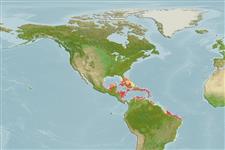Environment: milieu / climate zone / depth range / distribution range
Ekologi
laut berasosiasi dengan karang; kisaran kedalaman 3 - 15 m (Ref. 9710). Tropical
Western Central Atlantic: there are two color morphs that may be genetically different. Form 1 (brown dorsally and yellow ventrally, the brown pigment may extend farther ventrally than the blue pigment in form 2, leaving only the ventral surface yellow ) is found in Central America. Form 2 (blue or brown dorsally and yellow ventrally) is found in the Virgin Islands and the Greater Antilles. The only record from the Lesser Antilles is from Dominica. Although one specimen has been recorded from Florida (UMML 7085, specimen missing) this locality may be in error because no other specimen has been sighted in Florida apart from that record.
Size / Weight / umur
Maturity: Lm ? range ? - ? cm
Max length : 13.0 cm TL jantan/; (Ref. 9710)
Form 1: divided into brown dorsally and yellow ventrally (margin between the two colors usually located at the midline, but the brown may sometimes extend lower leaving only the belly yellow); dorsal fin brown, all other fins yellow to yellowish brown; face brownish yellow; sometimes with a small black spot occurring at the dorsal region of the caudal peduncle. Form 2: divided into blue or brown dorsally (the blue pigment covering a much smaller area than the brown pigment in form 1, restricted to the region of the back and not extending to the midline).
A solitary species (Ref. 26340) inhabiting rocky and coral reefs (Ref. 9710). Feeds on crustaceans (primarily shrimps) (Ref. 26180).
Life cycle and mating behavior
Kematangan | Reproduksi, perkembang biakan | Pemijahan | telur-telur | Fecundity | Larva
Domeier, M.L., 1994. Speciation in the serranid fish Hypoplectrus. Bull. Mar. Sci. 54(1):103-141. (Ref. 26407)
Status IUCN Red List (Ref. 130435)
ancaman kepada manusia
Harmless
penggunaan manusia
Perikanan:
informasi lanjut
Nama-nama umumSinonim (persamaan)metabolismePemangsaEkotoksikologiReproduksi, perkembang biakanKematanganPemijahanSpawning aggregationFecunditytelur-telurpekembangan telor
AcuanBudidaya airprofil budidaya airStrainGenetikaElectrophoresesDiturunkanPenyakit-penyakitPengolahanNutrientsMass conversion
Alat, peralatan
laporan khas
muat turun XML
Sumber internet
Estimates based on models
Preferred temperature (Ref.
123201): 26.7 - 28.3, mean 27.6 °C (based on 448 cells).
Phylogenetic diversity index (Ref.
82804): PD
50 = 0.5000 [Uniqueness, from 0.5 = low to 2.0 = high].
Bayesian length-weight: a=0.01778 (0.00680 - 0.04650), b=3.03 (2.80 - 3.26), in cm total length, based on LWR estimates for this (Sub)family-body shape (Ref.
93245).
Trophic level (Ref.
69278): 3.6 ±0.59 se; based on food items.
Daya lenting (Ref.
120179): Tinggi, Waktu penggandaan populasi minimum kurang dari 15 bulan (Preliminary K or Fecundity.).
Fishing Vulnerability (Ref.
59153): Low vulnerability (10 of 100).
Nutrients (Ref.
124155): Calcium = 90 [50, 174] mg/100g; Iron = 0.698 [0.369, 1.316] mg/100g; Protein = 18 [16, 20] %; Omega3 = 0.122 [0.071, 0.205] g/100g; Selenium = 22.2 [12.2, 45.1] μg/100g; VitaminA = 93.3 [24.9, 398.6] μg/100g; Zinc = 1.43 [0.91, 2.18] mg/100g (wet weight);
